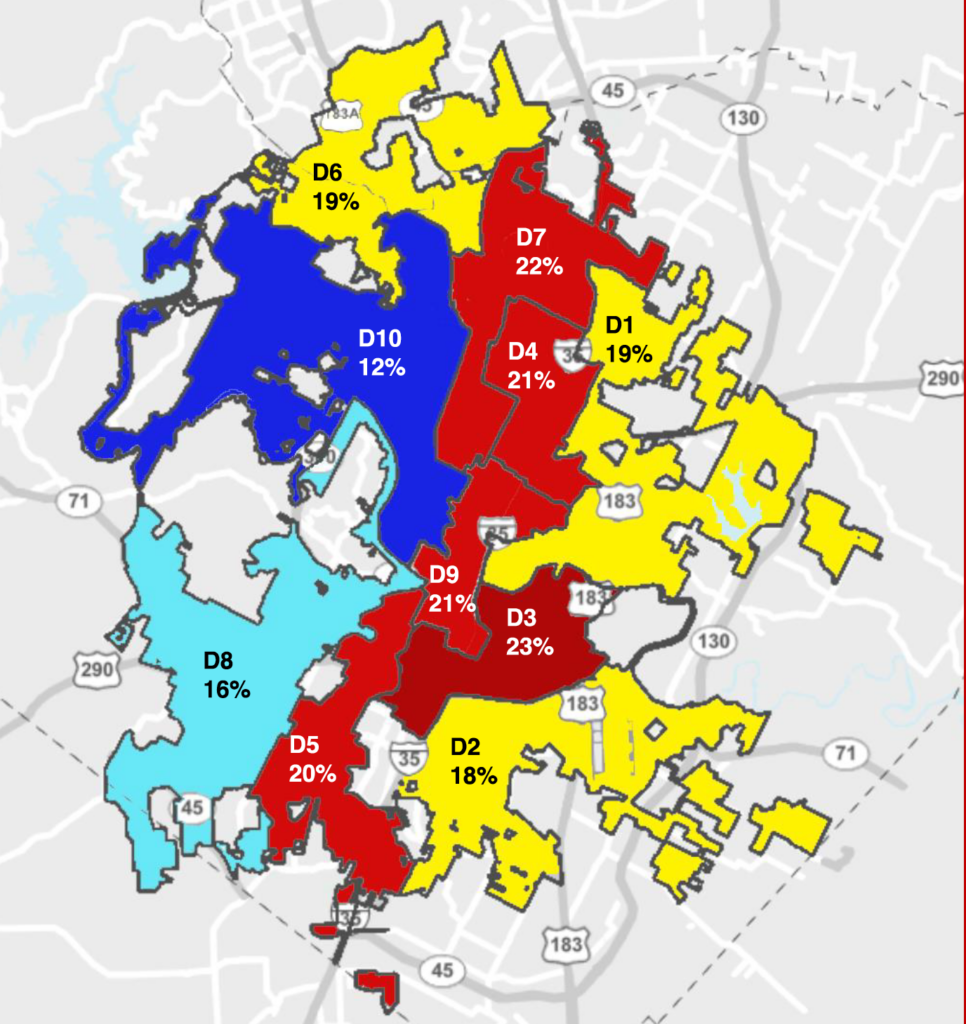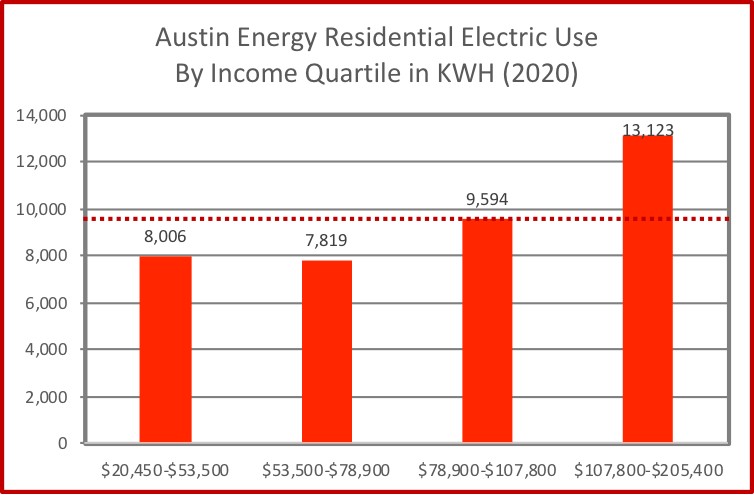Almost two years after Winter Storm Uri crippled the unprepared Texas electric system and knocked out power to 40 percent of buildings, Winter Storm Mara slammed a broad swath of Texas. Buildings that lost electricity stretched from as far south as New Braunfels all the way to northeast Texas counties along the Red River. The weight of freezing rain that clung to trees brought them down on powerlines and power poles, knocking out electricity not only for Austin Energy customers but also a noticeable percentage of customers in at least 30 other Texas counties.
At the worst point, about a third of Austin Energy customers were without power. The largest number of customers who lost power in this storm lived right here in Travis County. Restoring their power was exponentially complicated by the need to remove thousands of downed tree limbs, install new power lines and poles, and gain access to seldom-used utility easements bordering private property, and do almost all that in cold weather. It took almost two weeks to restore power to all customers.

Austin Energy has been lambasted by critics from across the local political spectrum. Still haunted by the post-traumatic stress of extended massive power outages suffered during Winter Storm Uri two years ago, its customers are bitterly angry at what they viewed as incompetence. City Manager Spencer Cronk was fired in mid-February, partially based on his perceived mishandling of the situation.
But if you think confidence in Austin’s City government cannot go any lower, you probably need to adjust your expectations.
On March 1st, Austin Energy began levying its new rate increase that raised electric bills for the majority of residential customers. It will punish poor people. It will discourage energy conservation by making Austin’s rates more “regressive,” meaning consumers who use the least amount of electricity will receive the steepest increases in electric rates, while customers such as mansion owners who use the most power will receive no increase or even a slight decrease.
This is a massive reversal of longstanding precedents on energy efficiency and financial equity that have been in effect for decades for the city-owned electric utility.
An independent analysis
Using data supplied by Austin Energy, I have analyzed how the new rates effective March 1st will affect each City Council District based on actual consumption in 2021.
Austin Energy could have conducted this analysis on its own. However, there is a high probability that it did not pursue this because it would have discouraged the City Council from approving the new rate structure.
The analysis revealed that, in a city that proclaims equity and energy conservation as almost-sacred community values, Austin Energy’s new electric rate system has failed abysmally in distributing the new rate increase fairly.
How new rates punish, reward council districts
The accompanying map pinpoints how the rate increase will affect the residential ratepayers in each of the 10 council districts.
 District 3, Austin’s poorest area when measured by households with low to moderate incomes, will experience a 23 percent rate increase, followed closely by District 7 at 22 percent, Districts 4 and 9 at 21 percent, and District 5 at 20 percent.
District 3, Austin’s poorest area when measured by households with low to moderate incomes, will experience a 23 percent rate increase, followed closely by District 7 at 22 percent, Districts 4 and 9 at 21 percent, and District 5 at 20 percent.
On the other end of the spectrum, the most affluent Districts 8 and 10 will be much less affected by the rate increase, as will District 2. The 12 percent rate increase in District 10 is roughly half of what it is in District 3 yet the average residential consumption in District 10 is 53 percent higher than District 3.
In fact, 4 percent of residential customers will literally see no increase at all or even a slight decrease. This relatively small number of customers has a gargantuan appetite for power, consuming 13 percent of all the residential electricity in the city of Austin.
The rate increases are directly inverse to consumption: the less you use, the greater the increase.
Income and consumption
The new rate structure punishes consumers who use less energy because they are either poor or choose to conserve energy.

As acknowledged by rate experts for decades, energy consumption and income are inextricably linked. As a rule, people with higher incomes use more power because they can afford the additional service for more comfortable homes, more space in these comfortable homes, and more gadgets and appliances. The accompanying chart shows that consumption increases by income.
An unexpected find
Interestingly, two of the poorer East Austin Districts 1 and 2 were not harmed as much as might be expected. Both districts will receive rate increases lower than Districts 3 and 4.
I looked for clues as to why this is occurring from zip code data in the U.S. Census American Community Survey. While zip codes do not precisely match Austin’s single member district boundaries, some zip codes fall largely or totally within them.
The difference appears to be, in a phrase, more all-electric dwellings. Homes in Districts 1 and 2 are newer than some other areas of Austin. The land is often undeveloped and cheaper, providing fodder for new subdivisions. These newer buildings tend to be larger with more rooms, and a large percentage of them are without natural gas service.
All-electric heating is less expensive to install than natural gas, so apartment builders and low-end tract home builders have a preference for electric. Although this may lower the cost of housing, it drives up electric consumption. So while the homes in Districts 1 and 2 consume more power than homes in Districts 3 and 4, because of the new and more regressive rate structure, their per-unit cost will be less.
Since all-electric heating drives up summer and winter peak demand for electricity, it drives up all customers’ bills to pay for the needed additional capacity. One would think Austin Energy would have more of an interest in mitigating the effects with stricter building codes that require more efficient structures or by offering more rebates for high-efficiency heating and water heating. But such foresight in utility planning is not apparent.
A brief history of energy and equity in Austin
It’s rare for an Austin City Council meeting to be conducted without some mention of equity. The word comes up repeatedly in discussions about affordable housing bonds, the Austin Housing Authority, the City’s nine-person Equity Office, and helping or housing the homeless. In the current fiscal year, Austin has budgeted $79 million for homelessness response and at least $59 million for affordable housing.
Austin has a long history of helping lower-income customers with their energy bills going back to the 1970s.
These efforts began around 1977 with the City’s administration of a federal grant program to weatherize low-income homes. Austin Energy took over funding of this program in the early 1980s, and continues to do so.
In 1981, Austin created a “lifeline” electric rate structure to make bills more affordable. It consisted of a two-tiered rate structure that charged less for the first 500 kilowatt hours. This rate was created to give low-income households a break on their bill and incentivize energy conservation.
In 1989, the City created a program to weatherize multifamily units. Though not specifically created to help low-income people, the income of people in rental units is typically well below incomes of people in owner-occupied housing. In 2021, Travis County Census data showed occupants of rental units earned less than half the income of homeowners. The multifamily program saved an estimated 127 million kilowatt-hours a year for multifamily customers who participated between 2007 and 2021, collectively saving them about $13 million annually. For many years, this was one of the only programs of its kind in the country.
Austin’s SMART (Safe, Mixed-Income, Accessible, Reasonably priced, Transit-oriented) Housing program waives certain fees if a developer agrees to achieve a certain standard of affordable housing, which includes participation in the Austin Energy Green Building program that includes saving electricity. Between 2007 and 2022, there were 24,251 dwelling units rated by this program.
In 2013, a new electric rate structure was created that made Austin’s residential rates even more progressive. A five-tiered rate structure replaced the two-tiered system, and imposed even higher costs for large consumers. This five-tiered structure was reaffirmed when rates were changed again in 2017.
In both of these rate cases, Austin Energy attempted to make the five-tiered rate structure much more regressive by offering lower per-unit cost for higher consumption. Its attempts were beaten back by the consumer advocates and instead Austin’s rate structure became one of the most progressive in Texas.
According to 2021 data from the U.S. Energy Information Administration, Austin Energy residential customers had the lowest average consumption of any major utility in the Electric Reliability Council of Texas (ERCOT) grid. Only 2 percent of ERCOT residential customers had average consumption lower than Austin.
Austin’s conservation programs and, up until now progressive rates, have been tremendous tools to help fight climate change.
A quantum leap backwards
In the 1980s the City’s focus on rewarding conservation was expressed politically through the strategy that energy saving programs were, in effect, creating a “conservation power plant,” meaning that reduced consumption would avoid the need to build costly new power plants.
Now the impressive achievements accomplished by progressive electric rates are being undercut as the utility has succeeded in gaining City Council approval to partially reverse the conservation strategy.
In 2022, during the bitterly fought rate case—in which I was one of some 10 interveners—Austin Energy claimed it could not pay its bills if the rate structure was not radically changed, calling progressive rates a “brutal price signal to focus on conservation.” Yet after the more steeply progressive rates went into effect in 2013, Austin Energy accrued a surplus leading to a rate reduction four years later.
The utility won its new rate structure with the City Council’s 7-4 December vote. Those voting for the new rates were Mayor Steve Adler and Council Members Natasha Harper-Madison, Sabino “Pio” Renteria, Jose “Chito” Vela, Mackenzie Kelly, Leslie Pool, and Paige Ellis.
Voting against the higher rates were Council Members Vanessa Fuentes, Ann Kitchen, Kathie Tovo, and Alison Alter.
While the new rate structure will hurt a vast number of electric consumers, it could have been worse. Austin Energy’s original proposal was profoundly more regressive. Instead of giving no rate increase or a slight (2 percent) rate decrease to large consumers living in mansions, it proposed rate decreases as high as 40 percent. It is highly likely that in the next rate case, the utility will come back to seek what it did not win this time.
Lost in these discussions is how the public will respond. Many people do not read the news closely, or understand the issues and political machinations of a rate case. But they do read their utility bills.
It would be unwise for City officials to lecture Austin ratepayers about the need for shared sacrifice and “taking one for the team.” After Winter Storms Uri and Mara, most of them figure they already have.
Thanks to Ken Martin, Janis Morgan and Tony Switzer for editing this article.
 Trust indicators: Paul Robbins is an environmental activist and consumer advocate who has lived in Austin for five decades. He is editor of the Austin Environmental Directory, a sourcebook of environmental issues, products, services, and organizations in Central Texas. The publication has been offered free to the public since 1995, and can be accessed free online.
Trust indicators: Paul Robbins is an environmental activist and consumer advocate who has lived in Austin for five decades. He is editor of the Austin Environmental Directory, a sourcebook of environmental issues, products, services, and organizations in Central Texas. The publication has been offered free to the public since 1995, and can be accessed free online.








Not the Bulldog’s best work. Paul just ignores that the Council treats Austin Energy as its piggy bank, so the end game is maxing revenue for their pet projects. Rate increase % by district is a data artifact that doesn’t really factor into maxing overall revenue. I’m pretty sure Paul would accept higher rates across the board if it reduced consumption to serve his climate change initiatives… and he’d be fine with the current rate structure if it was intended to fund his pet projects.
Dear Steve,
You are incorrect in stating that I “would accept higher rates across the board if it reduced
consumption to serve his climate change initiatives.”
As one of about 10 active intervenors in the Austin rate case in 2022, I highlighted ways that the rate increase itself could be largely or totally avoided. I spent a considerable amount of volunteer time on this.
I am sending a link to a story that I wrote about the subject late last year should you be interested.
https://environmentaldirectory.info/come-this-winter-part-3/
Yours,
Paul
The article is about energy rates not the City’s piggy bank. Let’s not use just one of Paul’s “agendas” — climate change — as a weapon. Clearly, he is talking about energy rates, equity and climate change. All good stuff to have in the mix of some poor decisions by the majority Council. Thanks for publishing, Bull Doggy.
This analysis totally ignores the fact that the power distribution infrastructure has a large cost whether or not there is any significant consumption of electricity. Spreading those costs among all who are on the grid is both reasonable and appropriate.
There are several ways of looking at costs, and the one that you refer to is the one that Austin Energy favors.
But there are valid reasons for a cost-based conservation rate.
1. Peak power costs more than average power.
As example. using the kwh cost for 2022 for the Austin Energy load zone derived from ERCOT data, an annual hourly average over the entire year shows that at 5 PM, the cost is almost 12¢. This falls to less than half that in the early hours of the morning.
If a customer is not using power at peak, why shouldn’t the customer be financially rewarded?
2. The same theory goes for infrastructure. Transmission and Distribution are sized for peak demand. And as you probably know, T&D also works less efficiently at peak demand. So why isn’t a customer with no- or low-demand financially rewarded?
3. The same goes for ERCOT Regulatory costs, which I am fairly certain are apportioned according to a utility’s demands on the system.
4. And there are also future cost savings for deferral of new power plants with conservation.
My article contains informed opinions based on these considerations. I am sorry you do not agree.
Yours,
Paul Robbins
Probably just coincidence, but crusading electric commissioner and all around great Austinite Shudde Fath had to pass before the City took this step towards reversing inverted block rates
Honestly,
it’s hard to take. As a retired Austinite of 40 years now on a fixed income and
all ready paying a startling amount of property tax, the utility increases for basic services like gas, electricity, water, and telephone make it very difficult to feel like our quality of life isn’t threatened. Equity doesn’t even seem much of a consideration anymore, although of course it should be…thanks to Ken and the Bulldog for helping us stay on top of things…
Why is my daughter paying $600 a month for electricity in a 3 bedroom house in Austin?
I cannot answer this question/statement well because I have never been to the home.
Despite Austin Energy’s outrageous bill increases, it offers information, loans, and rebates for upgrades such as energy efficient air conditioning, duct sealing, window shading, attic insulation, and weatherization.
Also, the City has one bill for several utilities, including water, drainage, and solid waste, as well as electricity. It is possible that this is a contributing factor.
Paul Robbins